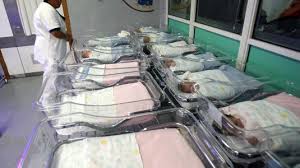Italy a dying country? It’s not only numbers that count!
 Italian health minister Beatrice Lorenzin, whom by the way I generally consider a pretty sharp lady, says Italy’s lowest number ever of live births means the country is “dying” and that something must be done. I’m not so sure that there is anything really new about this nor whether it is really Italy’s biggest problem or even a major one.
Italian health minister Beatrice Lorenzin, whom by the way I generally consider a pretty sharp lady, says Italy’s lowest number ever of live births means the country is “dying” and that something must be done. I’m not so sure that there is anything really new about this nor whether it is really Italy’s biggest problem or even a major one.
Italy’s biggest problem, aside from the world economic downturn from which much of Europe has yet to emerge, is that for many years now its elected officials – the so-called classe politica − simply have not been doing a good job of governing the country. Lorenzin (who will herself have twins in June) may be worried that along the road there won’t be enough young people to bear the burden of their aging countrymen. But since none of a series of governments – starting with Mr. B. who likes to pretend he did something for his country but, of course, did nothing – has been able to find jobs for some 44% of younger Italians, we can only be thankful that there aren’t more of them around.
Of course, demographics count. In theory. If there aren’t enough young people (and, shall I add, young people who have jobs AND pay taxes) the costs of maintaining the older population – retired, and possibly sickly – will become unbearable. But if there are lots of young people and there are no jobs for them, you can factor in social discontent as another thing for a government to deal with.
In any case, Italy’s ground-level birth rate has been a big story for at least 20 years now; I remember writing stories about this in the nineties when the birthrate – now apparently at 1.39, was even lower (if a birthrate is below 2.0 it means for sure that the current population will never replete itself fully).
The difference today, as the latest statistics indicate, is that women born in what we used to call third-world countries who now live in Italy also are having fewer children than they did until recently. This may be a temporary situation, to the extent that it reflects Italy’s troubled economic situation. But it may also be that some of these foreign-born women now may have learned how not, to use Pope Francis’s words, to reproduce like rabbits.
Despite the obstacles presented by the shenanigans of so-called conscientious objecting Italian doctors and sometimes pharmacists, contraceptives abound here and abortion is available – even if a woman might have to travel – up until the end of the third month of pregnancy. Additionally, last year immigration itself (that is, legal immigration) declined, probably because potential immigrants know that the economic situation in Italy currently makes finding a job very difficult.
According to the latest data, fewer babies were born in Italy in 2014 than in any other year since the modern Italian state was formed in 1861. ISTAT, the Italian national statistics institute, said on Thursday that the number of live births last year was 509,000, or 5,000 fewer than in 2013, and this time the figure includes children born to resident foreigners. In the past, the shortfall in Italian births was made up for by the number of non-Italian births.
The mortality rate also declined last year, stretching life expectancy for Italian men to 80.2 years, and to 84.9 years for women. The number of deaths registered in Italy last year was 597,000 while some 65,000 Italian citizens decided to go and live elsewhere. Only a positive balance of immigration (+207,000) enabled the population to expand marginally (0.04 percent to 60.8 million.)


